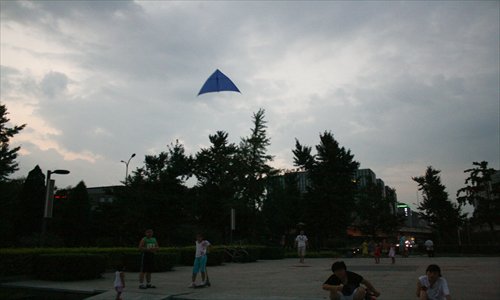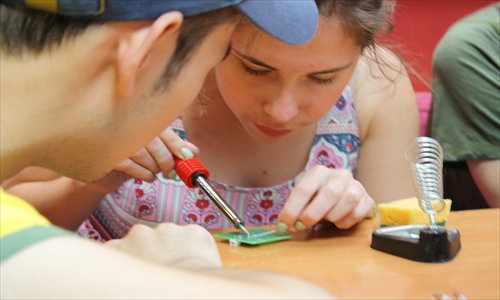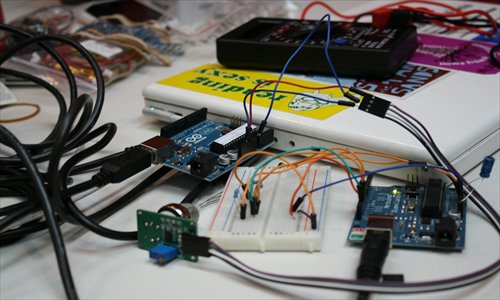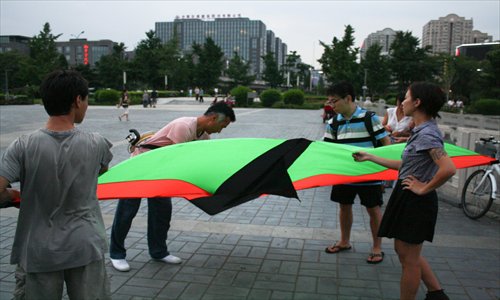Air data with strings attached




Until recently, the closest Beijing's tech geeks probably came to monitoring air pollution was from idling checking apps on their smartphones to see whether it's safe to venture outdoors to the local Internet café. But all that changed last weekend when a community art and design project lured geeks off the sofa and to a local park with some old Beijingers to change the way that people think about reporting air quality.
The brainchild of two budding American design students, the project dubbed "Float Beijing" aims to bring together people from local communities around the city and unite them in building air pollution monitors complete with colored LED indicators that can be attached to kites.
Dynamic designer duo
While airborne, sensors measure the amounts of various substances in the air, including carbon monoxide, nitrogen dioxide and volatile organic compounds. When levels are low, the lights on the sensors turn green, turning red when high. The color representing the most severe warning is, oddly enough, pink.
"When I was here in 2009, I noticed that Beijing has this really unique culture about it, even in the way people interact in the hutong. There's a real concern and passion from people for their community. It's different to somewhere like Shanghai, and I felt we could really tap into that," said Xiaowei Wang, a student at the Harvard Graduate School of Design. Wang jointly launched the project with Carnegie Mellon tangible interaction design student Deren Guler.
"People are already using [kites] for aerial mapping. It made a lot of sense to do air quality monitoring using kites, which is really traditional and exciting in China," said Wang. "What we're really hoping for is that there's a group of modules here that people, maybe university students, know how to make, and also that the kite flyers will keep some modules for themselves."
The duo proposed their idea on kickstarter.com, an online funding platform for creative projects, and managed to nearly double their $2,500 goal, raising $4,550 by July 19.
Now two workshops in, the project has caught the eye of a diverse cross-section of Beijing's brightest minds. Students, digital arts enthusiasts, hackers, environmental campaigners and even pensioners with a penchant for kite flying attended Saturday's workshop. Some stuck solely to sensors and soldering, while others were just there out of a Mary Poppins-esque love of kites.
Eye in the sky
Outside of the workshop, Wang and Guler have been shopping around Beijing's component markets looking for better deals on the chips that they're bringing to the next workshop. While microcontrollers and LEDs might sound complicated and expensive to the layman, Guler, who heads up the electronics section of the project, suggests that the project is accessible even to beginners.
Beijing hardly breaks the bank either for the duo, with a set of components costing as little as 70 yuan ($11) - about half the price they go for in the US. Sensors, on the other hand, are slightly more complicated.
"This is the first time using these sensors for this project, and it's been really exciting learning about new technology," Guler said. "Each sensor has a different chemical inside that reacts to the gas it's measuring and changes the conductivity of the sensor. It allows more electricity to flow through when it meets more of that gas."
Once the electricity runs through the chip, it converts the analog charge into digital information and lights the LED in the appropriate color depending on the air quality.
"The sensors themselves can be a little frustrating because they have to be preheated, but some have to be cycled through low and high voltages. Temperature and humidity can play a role in how sensitive they are," she added.
When normalizing the sensors indoors, it's necessary to do a test-run with some dirty air to make sure everything is in working order. This is usually done by calling on a smoker to spark up. Pensioner Cai Yubin was first on the scene, flipping out a silver cigarette case to light a test subject and blowing smoke onto the censor, which immediately turned red.
Cai, along with many others, was recruited on one of the group's preliminary trips to scope out volunteers. They enlisted the kite flyers at Deshengmen in Xicheng district, just a couple of kilometers from the workshop at newly opened music livehouse XP.
Public pollution watchdog
Cai told Metro Beijing he's not so interested in the tradition of kites, but rather pursues the hobby to keep active and get outdoors. Flying kites as high as he can is his "biggest delight," he said.
"I don't know so much about environmental issues, but I can really respect what's going on here," said Cai, talking on camera for a documentary that is being made about the project. "The air quality did get better after the [2008 Beijing] Olympics, but cars are still a big problem for Beijing."
Air quality monitoring has become a hot topic in the capital, especially since November 2010, when the US embassy's monitoring station posted that Beijing's air quality index exceeded 500, mockingly referred to in the official Twitter feed as "crazy bad."
The topic was widely discussed on Sina Weibo, the Chinese equivalent of Twitter, throughout 2011 leading up to the government releasing their own data on the especially harmful particulate matter 2.5 (PM2.5) earlier this year.
Wei Ji, a student at the Communications University of China, said he was drawn to Wang and Guler's project because air quality is "an important issue for people."
"I came because I'm interested in computer programming," Wei said. "But I think it's interesting that these two arts together can create new things that look at aspects of our daily lives. I've never seen the public monitor air pollution themselves before."
Some people head home from workshops after they have received their circuitry fix, but a steady group heads over to Deshengmen to see the kites in action over a kilometer high in the sky. Last Saturday, a rare blue sky day for Beijing, sensors could be seen flashing green right until they almost faded out of sight.
As the chips steadily record miniscule files of data, organizers haven't said officially what they'll be doing with the stats, including whether they will be posted online.
Those interested should check f-l-o-a-t.com for more information, or visit the next workshop this Saturday at 4 pm at XP.